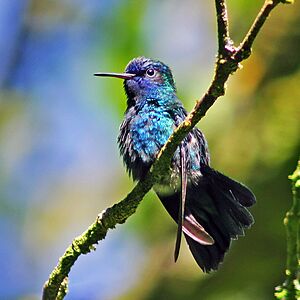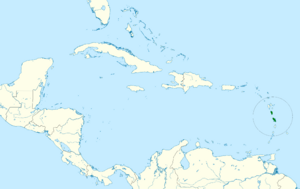Blue-headed hummingbird facts for kids
Quick facts for kids Blue-headed hummingbird |
|
|---|---|
 |
|
| Blue-headed hummingbird in Morne Diablotins National Park, Dominica | |
| Conservation status | |
| Scientific classification | |
| Genus: |
Riccordia
|
| Species: |
bicolor
|
 |
|
| Synonyms | |
|
Cyanophaia bicolor |
|
The blue-headed hummingbird (Riccordia bicolor) is a tiny, colorful hummingbird. It belongs to a group of hummingbirds often called "emeralds." You can only find this special bird on two islands in the Lesser Antilles: Dominica and Martinique.
Contents
About the Blue-Headed Hummingbird
Its Scientific Name and History
The blue-headed hummingbird got its first official description in 1788. A German scientist named Johann Friedrich Gmelin gave it the name Trochilus bicolor. He based his description on notes from a French scientist, Georges-Louis Leclerc.
For a long time, this hummingbird was the only species in its own group, called Cyanophaia. But scientists later studied its DNA and found it was closely related to other hummingbirds in a group called Riccordia. So, now it's part of the Riccordia group.
The name Riccordia honors a French surgeon-naturalist named Alexandre Ricord. The word bicolor is Latin, meaning "two-colored," which describes the bird's look. This hummingbird is monotypic, meaning it's the only species in its group.
What Does It Look Like?
The blue-headed hummingbird is about 9 to 11 centimeters (3.5 to 4.3 inches) long. Males weigh around 4.7 grams (0.17 ounces), and females are slightly lighter at 4.5 grams (0.16 ounces).
Male hummingbirds have a mostly black beak, with a pinkish bottom part. Their head and throat are a shiny violet-blue color. Their back is bright green, and the feathers near their tail are deep blue. Their tail is forked and steel blue. The rest of their underside is metallic green with a blue shine.
Female hummingbirds have an all-black beak. Their crown (top of the head) is shiny green. Their cheeks are dark with a small gray spot behind the eye. Their back and sides are bronze-green. Their tail is shiny bronze with a wide steel blue band and gray tips on the outer feathers. Their belly is pale brownish-gray.
Where It Lives
This hummingbird lives only on the islands of Dominica and Martinique. It prefers to live in the edges and inside of untouched forests. You can also find it in new forests growing along rivers. It's rare near the sea but is most common higher up, between 800 and 1000 meters (2,600 to 3,300 feet) above sea level.
How It Behaves
Staying in One Place
The blue-headed hummingbird is a sedentary bird. This means it doesn't migrate or move far from its home territory.
What It Eats
This hummingbird drinks nectar from many different kinds of flowers and trees. It feeds at all levels of the forest, from the ground to the treetops. Besides nectar, it also eats small insects and spiders. It catches them by flying out from a perch, especially over streams. It also picks them off leaves.
Building a Nest and Raising Chicks
The blue-headed hummingbird's breeding season is from March to May. The female builds a cup-shaped nest using soft plant fibers. These fibers often come from the silk-cotton (kapok) tree. She usually decorates the outside of the nest with dead leaves.
The nest is placed on horizontal branches or fern leaves. It's usually between 1 and 4 meters (3 to 13 feet) above the ground. The female lays two eggs and keeps them warm for 16 to 18 days. The young birds leave the nest about 20 to 23 days after hatching.
Its Calls
The blue-headed hummingbird makes several sounds. These include "shrill, metallic notes" that quickly drop in pitch. It also makes a metallic "click-click-click" sound.
Its Conservation Status
The IUCN (International Union for Conservation of Nature) says the blue-headed hummingbird is a species of "Least Concern." This means it's not currently in great danger of disappearing. However, it lives in a small area, and its population size isn't known. Scientists believe its numbers might be going down.
The bird is found in scattered groups on the two small islands. On Dominica, hurricanes in the 1980s greatly reduced its population. The numbers are only slowly recovering since then.


